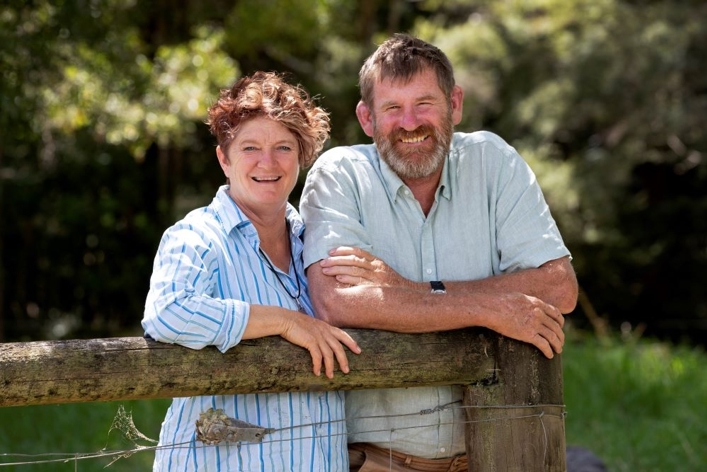Story
Kāeo farms thrive through smart choices, support: case study

Helen Linssen and Jeff Martin, Te Karoa Farms.
Working smarter, and always being willing to learn, is Jeff Martin and Helen Linssen’s recipe for farming success. The couple own three beef farms near Kāeo, and their focus on efficiency and environmental protection is paying off on many levels.
“Our ethos is that we’d like to improve rather than keeping our farm at the status quo. We’re using new technology and we’re open to new information all the time, so we can learn how to farm in a better way,” says Helen.
Since buying their first block of land together 20 years ago, they have embraced everything from erosion planting to GPS mapping technology to balance the farm budget, animal welfare, soil health and the environment.
Their work at Te Karoa Farms has attracted attention. Last year, they were the Regional Supreme Winners in the Northland Ballance Farm Environment Awards.
Jeff and Helen’s farming business covers 484ha across three properties of steep hills and rolling pastures, including 307ha effective, 80ha of native bush, and 34ha of fenced-off waterways and wetlands. They raise premium 100kg liveweight beef bulls, returning liveweight gains per hectare that are well above district averages.
The couple has worked with Northland Regional Council in various ways since 2001. They’ve received money from the Environment Fund to fence off waterways, says Jeff.
“The more fences and water you have, the better control you have over your pasture and the more you can harvest. Because the more fences you’ve got, the more paddocks you have, and you can slow down or speed up the length of time before a paddock is grazed again.”
“Without fencing, cattle get in and make a mess, compacting the soil so water runs off even more.”
Fencing also helps with stock retention, as the young Friesian cattle they farm have a nasty habit of falling into drains and dying, says Helen.
“Also, fencing looks nice aesthetically, it makes you feel like you’re doing something.”
She says many farmers think they’ll need to deal with weeds if they fence off waterways, but they haven’t had to worry about that. Northland’s subtropical climate means native plants – such as toetoe, punga, mānuka and kahikatea – regenerate remarkably quickly, given half a chance.
“The grass, particularly kikuyu, grows long if it’s left untouched, and it’s really good for stopping nutrients going into the river. We haven’t had to spray any of it, it seems to keep above the weeds,” explains Helen.
“We’re doing a bit of planting but we’re finding that it’s just growing back naturally because we’re surrounded by bush, so birds are dropping seeds.”
Farm environment advice from the council, and the land-use capability information on council’s website, helped them make crucial decisions on stocking rates to avoid pugging. They keep their cattle numbers at roughly 75% of the recommended level.
Jeff and Helen also used that information to create their land management units, which clock in at just 0.25ha per cell. A stock rotation cycle of 30 days in summer and 60 days in winter means the pasture has longer to recover and the harvest is more productive.
Farm management company AgDesign flew drones over their land, using GPS technology to map the land contours and work out where the water flowed into critical source areas. Then Helen and Jeff fenced off all waterways, wetlands and non-productive areas that were vulnerable to contaminant loss, and within that erected light, flexible fencing that makes shifting stock a quick job.
Another key element of their strategy was adapting to Northland’s specific conditions by stabilising hilly land, to deal better with runoff after heavy rain events, says Jeff.
“We’ve fenced for stock exclusion all the way up the hills, and sourced several hundred poplar poles from NRC’s nursery. We took cuttings off them and are growing our own now.”
The couple are quick to acknowledge the mentors who helped them over the years.
They’re paying it forward by mentoring others, and being actively involved in industry initiatives in the wider community, such as the Red Meat Profit Partnership to increase productivity and profitability through targeted advice to small groups.
Jeff is also part of Beef + Lamb New Zealand’s environmental reference group, made up of a dozen farmers from around the country who share information and ideas on environmental policy with each other, the organisation and government.
Just as council is moving to a catchment approach for water health instead of offering individual farm environment plans, Jeff plans to work with neighbours in their catchment. The aim is to all plant waterways together, for bigger environmental gains from hills to harbour, and better access to funding.
Unwittingly or not, Helen and Jeff are setting an example for others. They’re illustrating how a farming business can profit when it works in harmony with the environment.
“Everybody I know who’s involved in farming does it because of a love of the land,” says Jeff. “Being able to see the environment improved, and seeing waterways cleaner, is a great feeling. Developing infrastructure looks pretty good on your bank balance, too.”
Helen adds, “We live in it and we get a kick out of seeing it shine and improve all the time. It’s something we can leave for the next generation.”

Money from the Northland Regional Council's Environment Fund has helped to fence off waterways.
